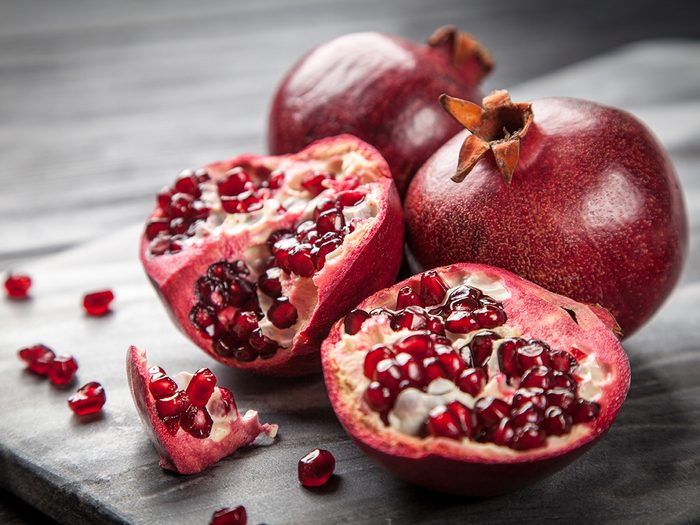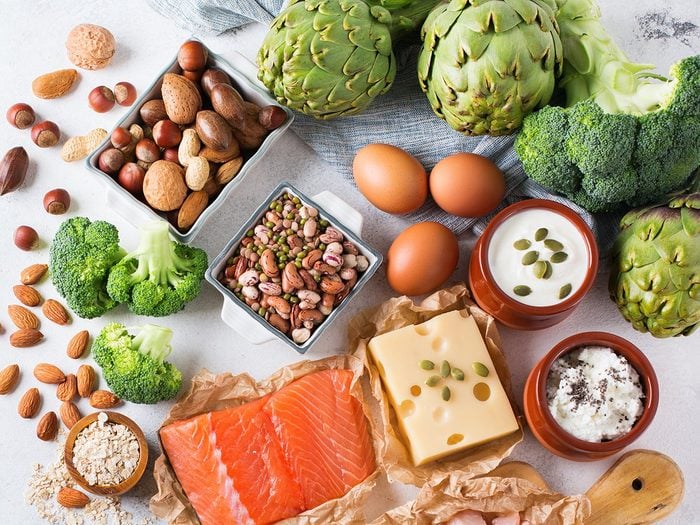
Simple steps to build muscles
Having strong muscles doesn’t just make you look and feel good—getting your muscles in shape will improve nearly every aspect of your life. Building muscle is good for your heart, your joints and your mind—and it doesn’t take hours of lifting heavy weights to do it. Here are five simple steps you can take every day to keep your muscles strong.

Try a pomegranate
Chock-full of health benefits, pomegranates may help preserve your muscle mass. Pomegranates are particularly rich in a molecule called ellagic acid (raspberries are another good source). In the gut, ellagic acid is transformed by microbes into a substance called urolithin A; a study published in Nature Metabolism in 2019 found that urolithin A enables muscle cells to protect themselves against the dysfunctional mitochondria associated with age.
Don’t miss our ultimate guide to healthy grocery shopping.

Get some sun
A little extra sunshine is good for both your body and mind. Research suggests that vitamin D—which humans mostly obtain through exposure to sunlight—can improve conditions like muscle weakness. Alternatively, studies have found that vitamin D deficiencies can lead to muscle wasting. Getting a little morning sun—no more than 15 minutes without sunscreen—can fire up the vitamin D-making machinery in your body.
Brush up on the essential vitamins your body needs to stay healthy.

Lift regularly
When it comes to rejuvenating muscles, resistance training is key. Although many adults exercise, a 2016 survey by AARP and Abbott found that 57 percent preferred cardio, while only 24 percent lift weights. “Evidence has really shown that doing those exercises can help you maintain your muscle,” says Tiffany Dewitt, a registered dietitian.
Lift weights you can heft between eight and 12 times; once you can lift a weight more than 12 times for a particular move, increase the amount. Focus on your entire body—think arms, chest, back, legs, and abdominals, and don’t rule out strength-building classes like yoga and Pilates.
Psst—these household items are fitness equipment in disguise!

Double up on protein
In the AARP survey, 62 percent of adults said they thought they got enough protein, and 70 percent reported increasing their intake of high-protein foods to minimize their risk of muscle loss. But interestingly, only 17 percent said they knew how much protein they needed. So what’s best for adults?
A minimum of 0.8 grams of protein per kilogram of weight (or for a 150-pound person, that’s 54 grams), according to the U.S. Department of Agriculture. If you don’t want to do the math, use the organization’s online calculator to figure out your proteins needs along with other nutrients.
But don’t get too caught up with numbers. Dietary guidelines recommend concentrating on eating protein-rich foods rather than focusing on a particular amount of protein. Dewitt suggests speaking with your doctor about protein intake and goals.
Find out the best protein sources, according to Canada’s Food Guide.

Include protein in all three meals
Instead of cramming in your protein requirements with a steak at dinner, aim to balance your protein intake throughout the day. One University of Texas study published in 2014 in the Journal of Nutrition found a 25 percent increase in muscle protein synthesis when protein intake was divided evenly into 30-gram servings for breakfast, lunch, and dinner, as opposed to when it was doled out randomly with an 11-gram serving at breakfast, 16 grams at lunch, and 63 grams at dinner.
So how much food equals 30 grams of protein? Think of an omelette with feta cheese, for example, or a serving of meat or poultry (roughly the size of a cellphone).
Next, learn to spot the signs you’re not getting enough protein.